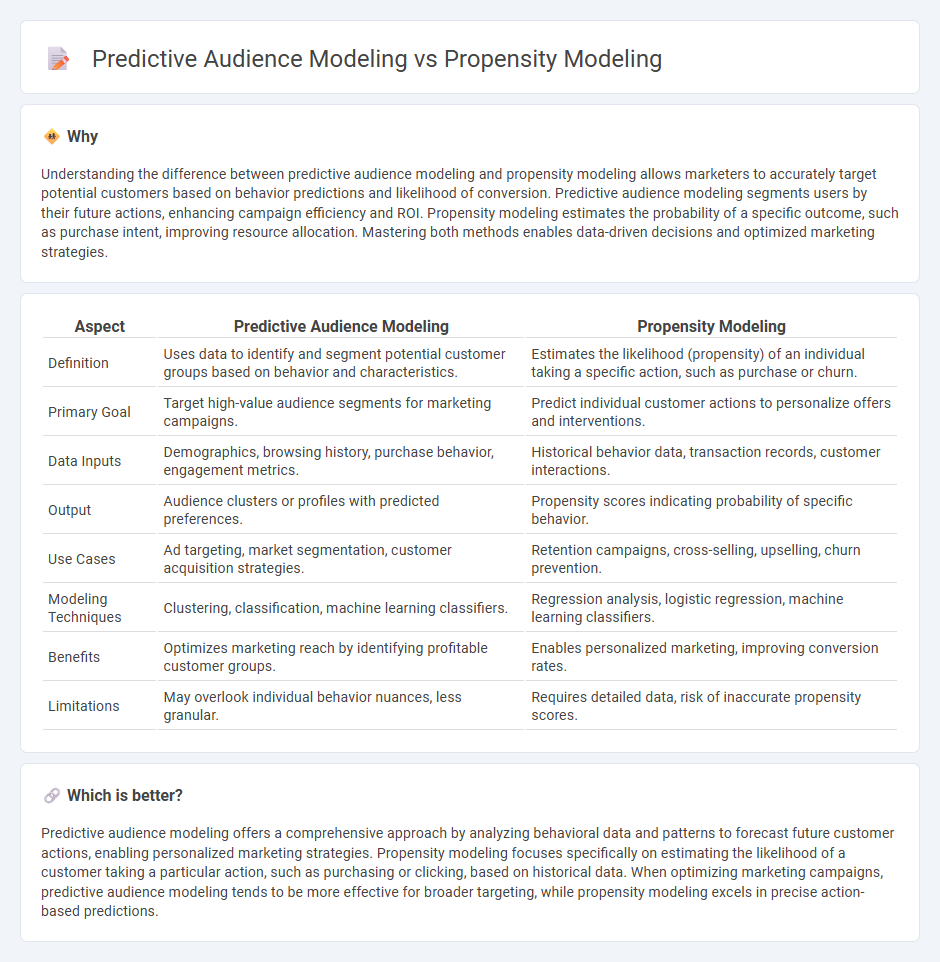
Predictive audience modeling leverages machine learning algorithms to analyze vast datasets and identify high-potential segments for targeted marketing campaigns. Propensity modeling estimates the likelihood of an individual's future behavior based on historical data, enabling personalized marketing strategies that increase conversion rates. Explore the key differences and applications to optimize your marketing efforts.
Why it is important
Understanding the difference between predictive audience modeling and propensity modeling allows marketers to accurately target potential customers based on behavior predictions and likelihood of conversion. Predictive audience modeling segments users by their future actions, enhancing campaign efficiency and ROI. Propensity modeling estimates the probability of a specific outcome, such as purchase intent, improving resource allocation. Mastering both methods enables data-driven decisions and optimized marketing strategies.
Comparison Table
| Aspect | Predictive Audience Modeling | Propensity Modeling |
|---|---|---|
| Definition | Uses data to identify and segment potential customer groups based on behavior and characteristics. | Estimates the likelihood (propensity) of an individual taking a specific action, such as purchase or churn. |
| Primary Goal | Target high-value audience segments for marketing campaigns. | Predict individual customer actions to personalize offers and interventions. |
| Data Inputs | Demographics, browsing history, purchase behavior, engagement metrics. | Historical behavior data, transaction records, customer interactions. |
| Output | Audience clusters or profiles with predicted preferences. | Propensity scores indicating probability of specific behavior. |
| Use Cases | Ad targeting, market segmentation, customer acquisition strategies. | Retention campaigns, cross-selling, upselling, churn prevention. |
| Modeling Techniques | Clustering, classification, machine learning classifiers. | Regression analysis, logistic regression, machine learning classifiers. |
| Benefits | Optimizes marketing reach by identifying profitable customer groups. | Enables personalized marketing, improving conversion rates. |
| Limitations | May overlook individual behavior nuances, less granular. | Requires detailed data, risk of inaccurate propensity scores. |
Which is better?
Predictive audience modeling offers a comprehensive approach by analyzing behavioral data and patterns to forecast future customer actions, enabling personalized marketing strategies. Propensity modeling focuses specifically on estimating the likelihood of a customer taking a particular action, such as purchasing or clicking, based on historical data. When optimizing marketing campaigns, predictive audience modeling tends to be more effective for broader targeting, while propensity modeling excels in precise action-based predictions.
Connection
Predictive audience modeling leverages historical data and machine learning algorithms to forecast future consumer behaviors, while propensity modeling specifically estimates the likelihood of individuals to take particular actions, such as purchasing or engaging with a campaign. Both methodologies utilize statistical analysis and behavioral data to segment audiences more effectively, enabling tailored marketing strategies that increase conversion rates. Integrating predictive audience modeling with propensity scores enhances targeting precision by identifying high-value prospects and optimizing resource allocation in digital marketing efforts.
Key Terms
**Propensity Modeling:**
Propensity modeling uses historical data and machine learning algorithms to estimate the likelihood of individuals performing a specific action, such as purchasing or churning, enabling personalized marketing strategies. This technique analyzes behavioral patterns, demographic attributes, and transaction history to forecast future behaviors with high precision. Explore how propensity modeling can enhance targeting accuracy and boost campaign ROI.
Likelihood Score
Propensity modeling evaluates the likelihood score indicating a customer's probability to exhibit a specific behavior, such as purchasing or churn, based on historical data and statistical analysis. Predictive audience modeling targets segments by aggregating likelihood scores across groups to optimize marketing strategies and audience targeting. Discover how leveraging likelihood scores enhances personalized marketing outcomes and drives business growth.
Target Variable
Propensity modeling focuses on estimating the likelihood of a specific behavior or outcome, such as purchase or churn, by analyzing historical data patterns linked to that target variable. Predictive audience modeling segments customers by predicting future engagement or conversion potential, often using broader behavioral and demographic attributes as target indicators. Explore deeper insights into how these models enhance targeted marketing strategies.
Source and External Links
An Introduction to Propensity Modeling - Propensity modeling uses statistical approaches to predict user actions based on historical data, such as page views and purchase behavior.
Propensity Modelling: Definition, types and use cases - This resource provides an overview of propensity modeling techniques, including logistic regression and neural networks, and discusses their applications in marketing.
Propensity Modeling - Propensity modeling utilizes statistical techniques and machine learning to predict customer actions like purchasing or responding to offers, helping optimize marketing strategies.
 dowidth.com
dowidth.com